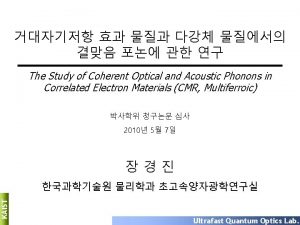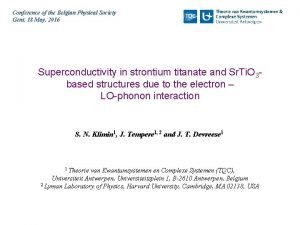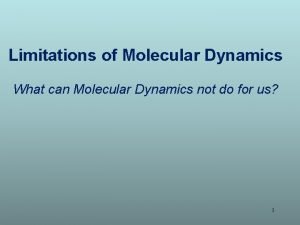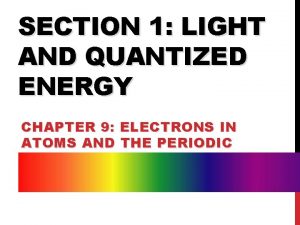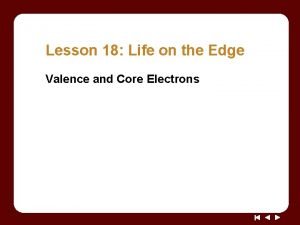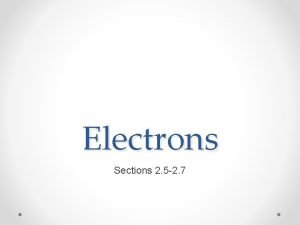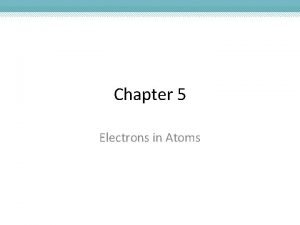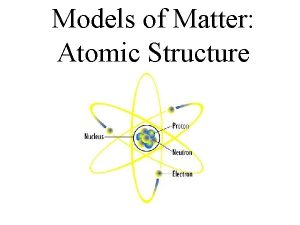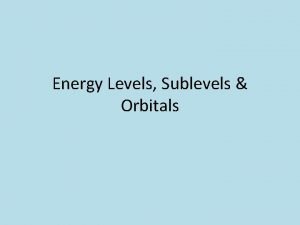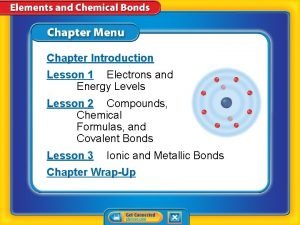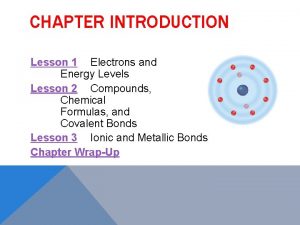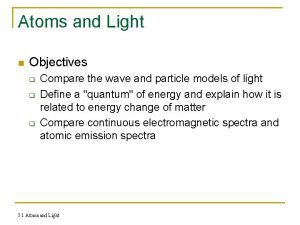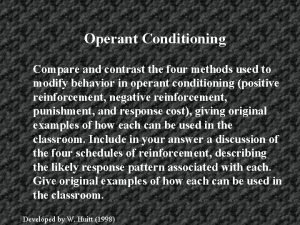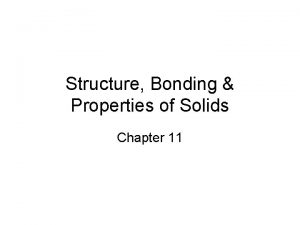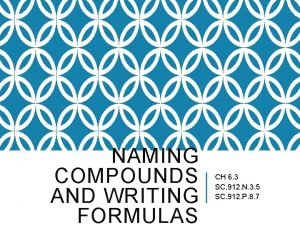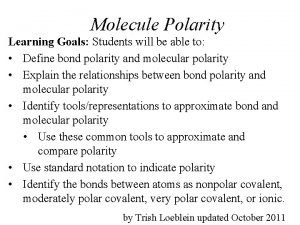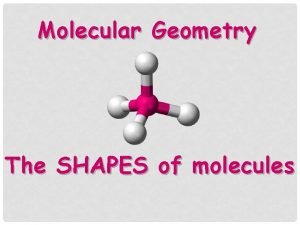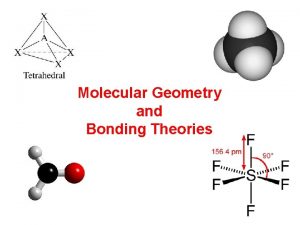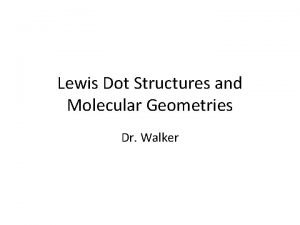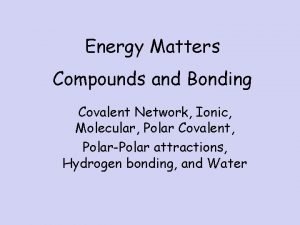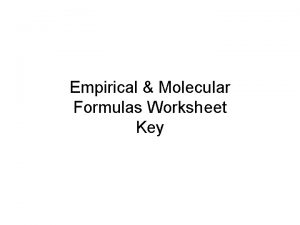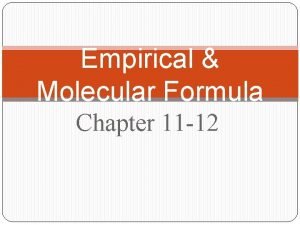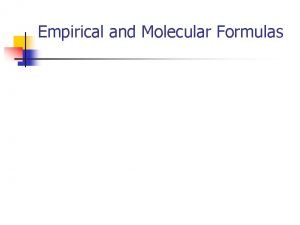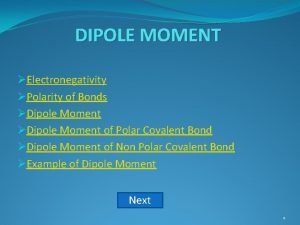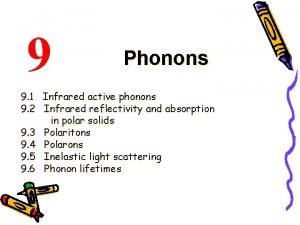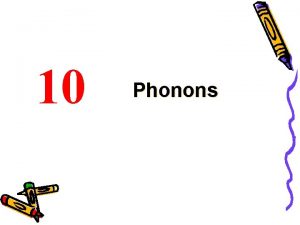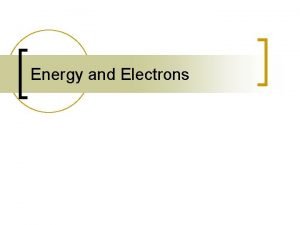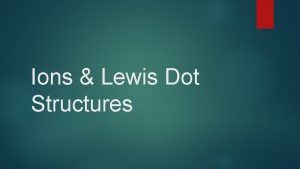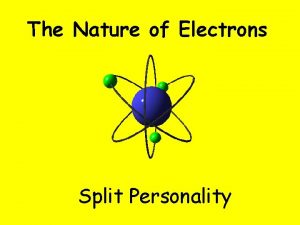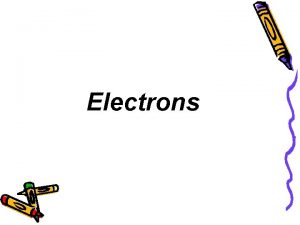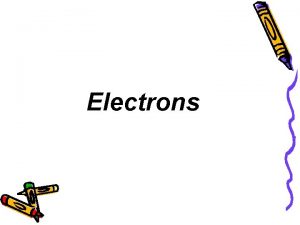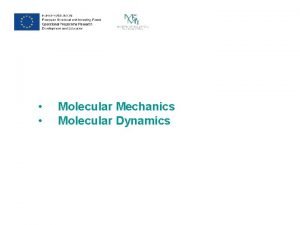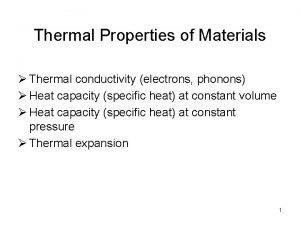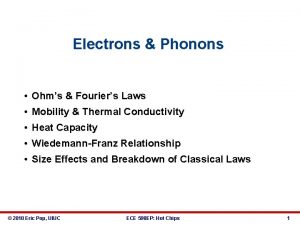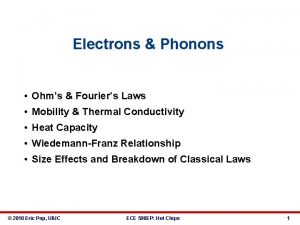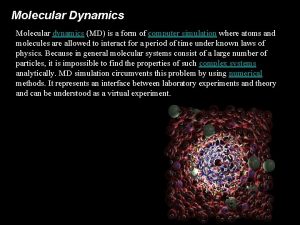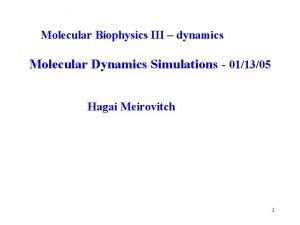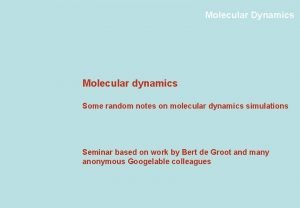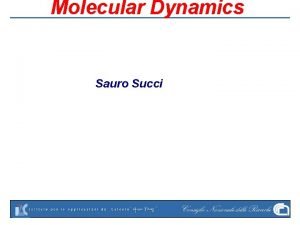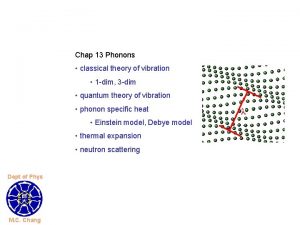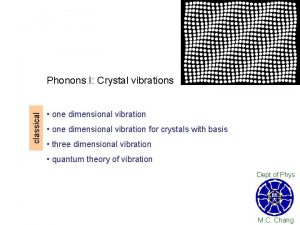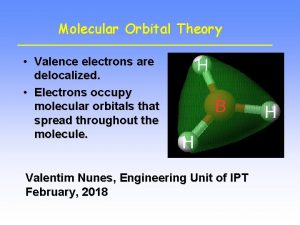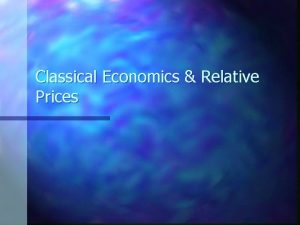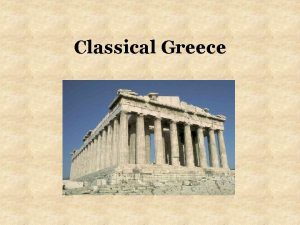Classical molecular dynamics of phonons and electrons with









































- Slides: 41

Classical molecular dynamics of phonons and electrons with quantum baths Jian-Sheng WANG 1

Outline • A quick introduction to molecular dynamics • Langevin equation • Generalized Langevin equation with quantum heat baths • Application examples – Quantum heat transport in nanostructure – Electron transport – Electron-magnet coupled system 2

Molecular Dynamics 3

Basic Idea • Solve Newton’s equations of motion • Choose a force field (specified by a potential V) appropriate for the given system under study • Decide a statistical ensemble to use, choice of boundary conditions; collect statistics of observables 4

Commonly Use Force Fields • Lennard-Jones Potential – For noble gas and generic fluids • Tersoff, Brenner, Stillinger-Weber, 3 -, 4 -body potentials – For C, Si, Ge, … • AMBER, CHARMM, GROMOS, MM 4, etc – For biomolecules • GULP, DFT codes, etc – For solids 5

Ensembles • Micro-canonical Ensemble – Energy is fixed • Canonical ensemble – Need to use “thermostat” to fix temperature • Langevin dynamics • Nosé-Hoover • Generalized Langevin 6

Langevin theory of Brownian motion (1908) P. Langevin 18721946 7

Langevin Dynamics 8

Observables, Statistics • Equilibrium temperature (in micro-canonical ensemble) by equipartition theorem. • Pressure of a fluid (for pair potential) Where d is dimension, Fij is the force acting on particle i from particle j. 9

Transport Coefficients • The diffusion constant can be computed through velocity correlation function 10

Transport Coefficients • Thermal conductivity can be computed through energy-current correlation using Green-Kubo formula; or nonequilibrium simulation by directly computing the energy current 11

Generalized Langevin Σ is known as self-energy 12

Quantum noise with Langevin dynamics • For thermal transport, Dhar & Roy, J Stat Phys (2006); JSW, PRL 99, 160601 (2007). • Thermostat to solids, Ceriotti, Bussi, Parinello, PRL 103, 030603 (2009); Dammak, Chalopin, Laroche, Mayoun, Greffet, PRL 103, 190601 (2009). • Kantorovich, et al, PRB 78, 094303 (2008); 94, 184305 (2016). 13

Thermal conduction at a junction Left Lead, TL semi-infinite Right Lead, TR Junction Part 14

Three regions Tc is contour order super-operator; u is 15

Quantum heat-bath & MD • Consider a junction system with left and right harmonic leads at equilibrium temperatures TL & TR, the Heisenberg equations of motion are • The equations for leads can be solved, given 16

Quantum Langevin equation for center • Eliminating the lead variables, we get where retarded self-energy and “random noise” terms are given as See JSW, Phys. Rev. Lett. 99, 160601 (2007); JSW, et al, Phys. Rev. B 80, 224302 (2009). (such idea for classical ensemble appears as early as in 1976, Adelman & Doll, JCP. But see Kantorovich PRB 2008) 17

Properties of the quantum noise For nonequilibrium Green’s function (NEGF) notations, see JSW, Wang, & Lü, Eur. Phys. J. B, 62, 381 (2008); or JSW, Agarwalla, Li, & hingna, Front. Phys. 9, 673 (2014). 18

Quasi-classical approximation (Schmid 1982) • Replace operators u. C & by ordinary numbers • Using the symmetrized quantum correlation, iħ(∑> +∑<)/2 for the correlation matrix of . • For linear systems, quasi-classical approximation turns out exact! See, e. g. , Dhar & Roy, J. Stat. Phys. 125, 805 (2006). 19

Implementation • Generate noise using fast Fourier transform • Solve the differential equation using velocity Verlet • Perform the kernel integration using a simple rectangular rule • Compute energy current by 20

Equilibrium simulation 1 D linear chain (red lines exact, open circles QMD) and nonlinear quartic onsite (crosses, QMD) of 128 atoms. From Eur. Phys. J. B, 62, 381 (2008). 21

Comparison of QMD with NEGF Three-atom junction with cubic nonlinearity (FPU ). From JSW, Wang, Zeng, PRB 74, 033408 (2006) & JSW, Wang, Lü, Eur. Phys. J. B, 62, 381 (2008). QMD ballistic QMD nonlinear k. L=1. 56 k. C=1. 38, t=1. 8 k. R=1. 44 22

From ballistic to diffusive transport Classical, ħ 0 4 16 NEGF, N=4 & 32 64 256 1 D chain with quartic onsite nonlinearity (Φ 4 model). The numbers indicate the length of the chains. From JSW, PRL 99, 160601 (2007). 1024 4096 23

FPU- model } relaxing rate NEGF It is not clear whether QMD over or under estimates the nonlinear effect. From Xu, JSW, Duan, Gu, & Li, PRB 78, 224303 (2008). 24

Conductance of graphene strips Sites 0 to 7 are fixed left lead and sites 28 to 35 are fixed right lead. Heat bath is applied to sites 8 to 15 at temperature TL and site 20 to 27 at TR. JSW, Ni, & Jiang, PRB 2009. 25

Zigzag (5, 0) carbon nanotubes Temperature dependence of thermal conductance (and conductivity) for lengths 4. 26 (green), 12. 8 (red) and 25. 6 (blue) nm, respectively. JSW, Ni and Jiang, PRB 2009. 26

Electron transport & phonons • For electrons in the tight-binding form interacting with phonons, the quantum Langevin equations are (set ħ = 1) 27

Quasi-classical approximation & NEGF D< ∑< n = i ∑rn = i G< G< { D< Dr + Gr G> Dr − Χ To lowest order in coupling M, quasiclassical approximation is to replace all G> by −G<. G< Π<n = −i G> Πrn = −i { Χ Gr G< + G< } } Ga 28

Ballistic electron transport, NEGF vs QMD Nearest neighbor hopping model with two sites in the center, lead hopping -hl = 0. 1 e. V, varying the center part hopping term. From Lü & JSW, J. Phys. : Condens. Matter 21, 025503 (2009). For NEGF method of electron -phonon interaction, see Lü & JSW, PRB 76, 165418 (2007). 29

Strong electron-phonon interactions ballistic Two-center-atom model with Su, Schrieffer & Heeger electron-phonon interaction. Lines are NEGF, dots are QMD. From Lü & JSW, J. Phys. : Condens. Matter, 21, 025503 (2009). 30

QMD is exact in low electron density limit Self-consistent Born approximation NEGF QMD Low electron density 31

Ballistic to diffusive Electronic conductance vs center junction size L. Electron-phonon interaction strength is m=0. 1 e. V. From Lü & JSW, J. Phys. : Condens. Matter, 21, 025503 (2009). 32

Electrons as a heat bath (Lü, Brandbyge, et al, based on path-integral formulism) 33

Joule heating from QMD Heat per unit time generated due to electric current for a 4 2 graphene armchair configuration. From Lü, et al, AIP Advances, 5, 053204 (2015). 34

A simplified QMD? • Consider the following Langevin equation for lattice vibration [Keblinski & JSW, unpublished; see also Buyukdagli, et al, PRE 78, 066702 (2008); Ceriotti, et al, JCTC (2010) ]: • then in the limit of small damping ( 0), the energy of the vibrational modes is given exactly as that of the corresponding quantum system. 35

df coupling model Spins sit on the corners of a cubic lattice, electron at the center of the lattice. Parameters: t ≈ 0. 2 e. V, JH ≈ 0. 1 e. V or less, lattice constant a = 3. 9 Å, J 1/k. B = - 0. 037 K, J 2/k. B = 0. 069 K, g = 2. Approaches: 1) Boltzmann + RPA 2) Dynamic mean-field 3) Exact diagonalisation 36

Magnetic polaron physics? • A single electron within the background sea of Heisenberg spins. • We can only talk about the mobility, v=μE; then σ = enμ is correct at low carrier density, say n≈10 -4 per unit cell. • Our approach: 1) Derive Heisenberg equations of motion for clσ, and Sj from the df coupling model. 2) replace Sj by a classical vector, replace clσ by complex number (i. e. , single particle wavefunction). 3) Simulating a single electron diffuses on lattice under the influence of fluctuating magnetic moments. 4) Determine the diffusion constant D, and use Einstein relation to get μ = D/(k. BT). 37

Operator-splitting method 38

Electron diffusion A typical MD run result of the mean -square displacement for a 2 D version of the model. Temperature T=2 K, JH=0. 005 e. V, t=0. 05 e. V. Unpublished, from Ruofan Chen. 39

Conclusion & Outlook • QMD for phonon is correct in the ballistic limit and high-temperature classical limit • Produce correct physics for single electron • Much large systems can be simulated (comparing to NEGF) • Quantum corrections in dynamics? – Solve a hierarchical set of Heisenberg equations (Prezhdo et al, JCP) – Can we treat the noises & as operators (i. e. matrices) thus restore ∑> ≠∑<? 40

Collaborators/students • • Baowen Li Pawel Keblinski Jian Wang Jingtao Lü Jin-Wu Jiang Eduardo Cuansing Nan Zeng • Lifa Zhang • Xiaoxi Ni • • Saikong Chin Chee Kwan Gan Jinghua Lan Yong Xu • Bijay Kumar Agarwalla • Thingna Juzar Yahya • Ruofan Chen 41
 Optical vs acoustic phonons
Optical vs acoustic phonons Phonons of physical fitness
Phonons of physical fitness The substance whose lewis structure shows a triple bond is
The substance whose lewis structure shows a triple bond is Covalently bonded substances
Covalently bonded substances Ionic covalent metallic
Ionic covalent metallic Giant molecular structure vs simple molecular structure
Giant molecular structure vs simple molecular structure Molecular dynamics limitations
Molecular dynamics limitations Electrons in atoms section 1 light and quantized energy
Electrons in atoms section 1 light and quantized energy Life on the edge valence and core electrons
Life on the edge valence and core electrons Introduction to basic chemistry
Introduction to basic chemistry Iodine valency
Iodine valency Electrons in atoms section 1 light and quantized energy
Electrons in atoms section 1 light and quantized energy Localized vs delocalized electrons
Localized vs delocalized electrons Lowest allowable energy state of an atom
Lowest allowable energy state of an atom Sulfur number of neutrons protons and electrons
Sulfur number of neutrons protons and electrons Energy levels of electrons
Energy levels of electrons Electrons in atoms section 2 quantum theory and the atom
Electrons in atoms section 2 quantum theory and the atom Lesson 1 electrons and energy levels
Lesson 1 electrons and energy levels Lesson 1 electrons and energy levels
Lesson 1 electrons and energy levels Gold number of neutron
Gold number of neutron Element name
Element name Electrons and light pogil activity 5-1
Electrons and light pogil activity 5-1 Compare and contrast operant and classical conditioning
Compare and contrast operant and classical conditioning Covalent molecular and covalent network
Covalent molecular and covalent network Kinetic molecular theory of liquids and solids
Kinetic molecular theory of liquids and solids Empirical and molecular formula
Empirical and molecular formula Naming compounds and writing formulas
Naming compounds and writing formulas Relationship between bond dipoles and molecular dipoles
Relationship between bond dipoles and molecular dipoles Nh bond polarity
Nh bond polarity Electron domain
Electron domain Theory of structures
Theory of structures Molecular geometry and bonding theories
Molecular geometry and bonding theories Bent lewis dot structure
Bent lewis dot structure Molecular theory of gases and liquids
Molecular theory of gases and liquids Covalent molecular and covalent network
Covalent molecular and covalent network Covalent molecular and covalent network
Covalent molecular and covalent network Silicon carbide covalent bond
Silicon carbide covalent bond Empirical and molecular formula worksheet
Empirical and molecular formula worksheet Which formula is an empirical formula?
Which formula is an empirical formula? Empirical and molecular formula
Empirical and molecular formula How to find empirical formula
How to find empirical formula Electronegativity and dipole moment
Electronegativity and dipole moment
